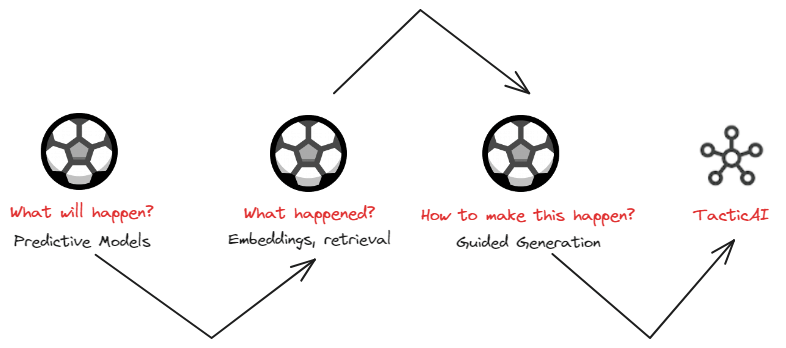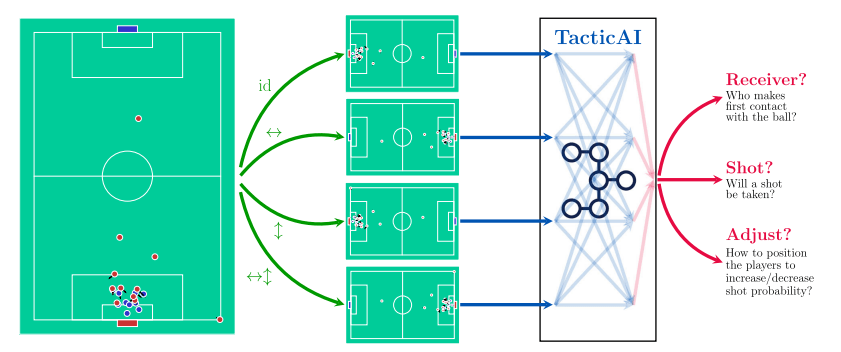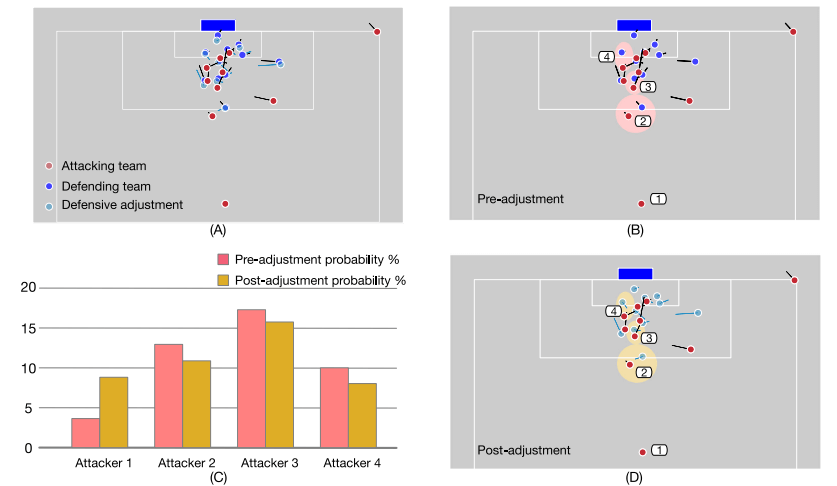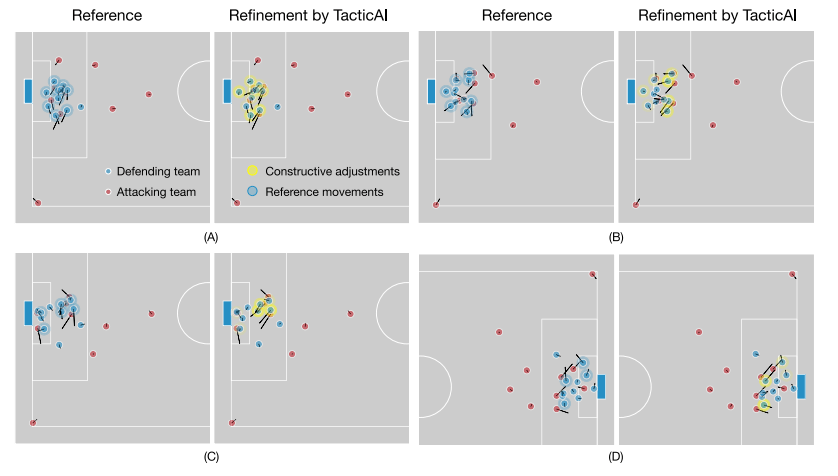Recently, Google DeepMind introduced TacticAI – an Artificial intelligence-based system that can provide coaches and players with tactical insights mainly on corner kicks through predictive analytics and generative AI models.
We're announcing TacticAI: an AI assistant capable of offering insights to football experts on corner kicks. ⚽
— Google DeepMind (@GoogleDeepMind) March 19, 2024
Developed with @LFC, it can help teams sample alternative player setups to evaluate possible outcomes, and achieves state-of-the-art results. 🧵… pic.twitter.com/8oVYtamGGe
Highlights:
- Google introduced TacticAI – an AI-based system that provides experts with tactical insights mainly on corner kicks.
- In 2020, DeepMind announced a multi-year research collaboration with football club Liverpool FC to enhance AI for sports analytics.
- TacticAI uses predictive and generative models which helps teams to approach corner kicks better.
TacticAI showcases how assistive AI methods have the potential to transform sports for players, coaches, and fans. Sports such as football offer a dynamic environment for AI development, characterized by real-world, multi-agent interactions and diverse data modalities.
Importance of Corner Kicks
In the 2019 UEFA Champions League Semifinal between Liverpool and FC Barcelona, Liverpool completed one of the most famous comebacks the sport has seen. With the score tied 3-3 on aggregate across both legs, it took a moment of genius from a corner kick taken by Trent Alexander-Arnold to set Divock Origi to score probably the greatest goal in Liverpool’s history.
The phrase ‘Corner taken quickly …. Origi!!’ has cemented its place as one of the most memorable utterances in the history of sports commentary.
Trent seemed to step back from the ball, causing a distraction for the FC Barcelona players, before swiftly delivering a corner kick that sealed the historic comeback. Liverpool then went on to win the Champions League thanks to this moment of quick thinking which caught out FC Barcelona. This shows the importance of corner kicks in football.
How was TacticAI Developed?
DeepMind developed and evaluated TacticAI together with experts from Liverpool Football Club as part of a research collaboration. Three years ago, Google DeepMind announced a multi-year collaboration with Liverpool FC to enhance AI for sports analytics. Over the last couple of years, they released a couple of research papers that demonstrated how AI can be used with a prototype of a predictive system for downstream tasks in football.
This meant that the system could predict the movement of players off-camera when no tracking data was available. Without this, a club would have to send a scout to watch every game in person.
Now, TacticAI has been developed as a full AI-based system that combines predictive and generative models. The system allows coaches to set up sample player setups for every routine followed in football and then evaluate the outcome of every such alternative.

What is TacticAI Built For?
Despite the scarcity of gold-standard data on corner kicks (on average, only about 10 corner kicks are taken in a Premier League match every season), TacticAI achieves cutting-edge results by leveraging a geometric deep-learning approach, enabling the creation of more generalized models.
TacticAI is built to address three main questions:
- For a given corner kick setup, what will happen? E.g., Who is most likely to receive the ball? What are the chances of a header?
- Once a setup has been played, is it able to understand what happened> E.g., Have such tactics worked well in past games?
- How can the tactics be adjusted to make a particular outcome happen? E.g., How should the defending players be repositioned to decrease the probability of a header? How to drag opposition players away to increase the chances of a goal?
TacticAI’s recommendations were favored by human expert raters 90% of the time compared to tactical setups observed in real practice.
How TacticAI Works?
A corner kick is granted when the ball crosses the byline after being touched by a defending team player. Forecasting the results of corner kicks is challenging because of the unpredictability stemming from individual player actions and their interactions.
Every player is regarded as a node within a graph. Node, edge, and graph features are extracted according to the methods outlined in the main text. Subsequently, a graph neural network processes this graph by executing message passing; each node’s representation is adjusted based on the messages it receives from its neighboring nodes.

TacticAI processes a given corner kick by subjecting it to all possible combinations of horizontal or vertical reflections to ensure robustness. These reflections generate four different views of the input corner, which are then inputted into the core TacticAI model.
Within this model, the views interact with each other to calculate the final player representations. Each internal blue arrow within the model corresponds to a single message passing layer from the preceding step. This can be seen in the image below:

Once player representations are computed, they serve multiple purposes, including predicting the corner’s receiver, determining if a shot has been taken, and suggesting adjustments to player positions and velocities. These adjustments aim to either increase or decrease the probability of a shot being taken.
Using these representations, TacticAI can address various predictive inquiries regarding corner outcomes, such as identifying the player most likely to make initial contact with the ball or predicting if a shot will occur.
Additionally, TacticAI functions as a retrieval system, allowing for the exploration of similar corner kick scenarios based on player representations, and as a generative recommendation system, proposing adjustments to player positions and velocities to optimize shot probability.
Through a series of experiments conducted in collaboration with expert coaches and analysts from Liverpool FC, they demonstrate that TacticAI consistently offers valuable, realistic, and precise tactical recommendations.
Dataset Used for Evaluating TacticAI
They assess the performance of the three components of TacticAI using a comprehensive benchmark dataset comprising 7176 corner kicks from the Premier League seasons of 2020 to 2021. This dataset is randomly divided into training (80%) and test (20%) sets.
Each corner kick situation is represented as a graph, with each node representing a player and associated features encoding their movements (velocities and positions) and basic profiles (heights and weights) at the time of the corner kick. The graphs are fully connected, with edges indicating whether players are on opposing teams.
Separate datasets of node, edge, and graph features, along with corresponding labels, are generated for each task. The components are trained individually with their respective corner kick graphs, using a minimal set of features that exclude ball movement and explicit encoding of distances between players.
A consistent training-test split is maintained across all benchmark tasks to enable the evaluation of both individual components and their interactions.
Example of TacticAI Making Adjustments in Corner Kicks
TacticAI equips coaches with the tools to fine-tune corner-kick strategies, increasing the chances of a favorable outcome for either team. Through precise player identification and timely tactical recommendations, TacticAI enables coaches to optimize their game plans effectively.
Below is an example of how TacticAI performs adjustments in corner routines:

In scenario (A), where a shot was attempted during a corner kick (B), TacticAI suggests adjusted configurations that lower the shot probability by repositioning defenders (D).
These adjustments decrease the receiver probability for attacking players 2–5 (as shown in the bottom row), while increasing the probability for Attacker 1, who is farther from the goalpost (C).
The model can generate various scenarios, allowing coaches to visually explore different options and leverage TacticAI’s quantitative analysis for further insights.
How TacticAI was Assessed?
To assess TacticAI, DeepMind’s team conducted a case study in collaboration with Liverpool FC (LFC), involving a panel of five football experts: three data scientists, one video analyst, and one coaching assistant. They each completed four tasks to evaluate various aspects of TacticAI’s components.
These tasks gauged the realism of TacticAI’s adjustments, the accuracy of its receiver predictions, the efficacy of its embeddings for retrieving similar corners, and the practicality of its recommended adjustments.
How TacticAI Refines Corners?
These examples, drawn from the case study with human experts, showcase the range of tactical adjustments proposed by TacticAI for teams defending a corner. The density of the yellow circles reflects the frequency with which each suggested change was deemed constructive by the human experts.
Rather than focusing on individual player movements, TacticAI can simultaneously recommend improvements for multiple players, such as suggesting better positions to block opposing players or more efficient tracking orientations. The different scenarios are explained in the image below:

- In scenario A, TacticAI suggests more favorable positions for several defenders and improved tracking runs for others. Additionally, the goalkeeper is positioned deeper, a change considered beneficial.
- In scenario B, TacticAI recommends improved covering runs for defenders farthest from the corner, a suggestion unanimously deemed useful, along with favorable positioning adjustments for other defenders.
- In scenario C, TacticAI suggests enhanced covering runs for a central group of defenders in the penalty box, unanimously recognized as significant by raters.
- In scenario D, TacticAI proposes substantially improved tracking runs for two central defenders and better positioning for two other defenders in the goal area.
During a blind test involving football experts, TacticAI’s recommendations were indistinguishable from real corner situations observed in previous games. When asked to select their preferred tactical advice, the group favored TacticAI’s suggestions over the original tactics 90% of the time.
Conclusion
The development of TacticAI represents a significant advancement in creating valuable AI assistants for sports. Future research endeavors could focus on expanding the capabilities of such assistants to incorporate a broader range of multimodal inputs beyond tracking data, thereby providing even greater support to experts in various ways. Stay tuned for further updates regarding TacticAI!








